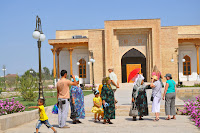(...)
We were once more guests of honour at a local city dweller, which I personally felt to be one of the high points of this circuit, the primary reason being because we were very well received by those who welcomed us in their homes, and apart from the fact that meals took a more familiar-like type of approach the actual food was almost certainly cooked with a lot more care and "love".
The house we walked in for this midday meal was really nice and so was the pasta, which in no way resembled the one we are used to in Western Europe. We were told it was hand made, which understandably accounted for the rather different consistency and taste.
After lunch I sat outside with our guide whilst we had a cigarette and we had a nice conversation over our own fears regarding the future, as if we had been friends for a while. In retrospect I feel that in no way did that affect her expected position as guide but got us closer as people who have to see and deal with each other on a daily basis and for a period of twelve consecutive days.


We were given a few hours of "freedom", once the atelier we had expected to visit was closed until three, so I decided to wander around the Lyabi Hauz complex where we had already been to several times without having been able to pay it the importance it really deserved. I stopped at the Nadir Divan Begi Madrasah, where the folk night and fashion show had been carried out the previous night and photographed its portal, whose decoration naturally caught one's attention because of the "simourghs" (phoenix birds), the white deer and the sun.
The inner courtyard where looked rather different from the previous night's without any carpets lying on the ground and the absence of lights, though it still looked as magnificent.
It is said that the Nadir Divan Begi Madrasah was initially built as a caravanserai but upon its opening Imankuli-Khan following the advice of the Sufi Sheikhs apparently congratulated the minister for the successful completion of the construction having unexpectedly named the building a madrasah. After this incident Nadir Divan-Begi felt obliged to adapt the caravanserei onto a madrasah (1630) by complementing the building with terraces, portals and towers, as well as have a second floor built in for the students.


As I walked out there stood the sculpture representing the well known Uzbek character Nasreddine and his donkey, overlooking the lake and the camel sculptures around it.



The Khanaka (site for merchants) Nadir Divan Begi could be seen just across the lake. This amazingly beautiful rectangle-shaped building is entirely decorated with epigraphic painting which does naturally catch one's attention. It is known as having been the cultural and religious centre of Bukhara for many centuries.

I sat around just watching the bustling and eventually talking to some school girls, who almost inevitably approached foreigners to practice the languages they were seemingly learning at school, even if they could merely say hello and good-bye it was still nice to have them wanting to converse. I took the opportunity to hand them out some decorated pens I had brought with me for such "encounters".
(to be continued)






















































